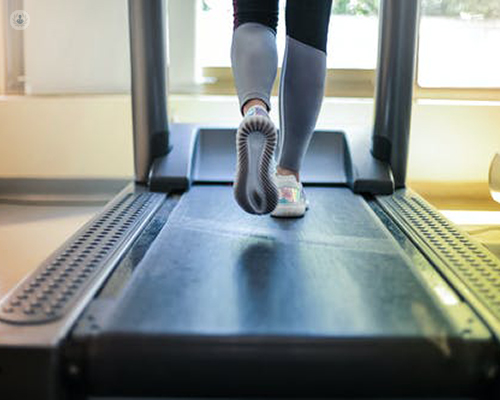Exercise stress test: what does it detect?
Escrito por:An exercise stress test also known as an exercise test or treadmill test is used to evaluate how your heart responds under stress or when it’s working at full strength. You would be attached to an ECG and blood pressure monitor to allow the doctor to check your heart rate and blood pressure during exercise.
Stress tests are generally considered safe as they are conducted in a controlled environment under supervision. In this article, one of our expert cardiologists Dr Sabiha Gati explains what a stress test detects exactly and what you can expect on the day.

What can the stress test detect?
There are several reasons why we may do an exercise test. The doctor may order the test if the patient was experiencing chest pains or other equivalent symptoms of coronary artery disease (CAD).
The test could also be used to evaluate the risk of sudden cardiac death in conditions such as cardiomyopathy and electrical faults or if there is a family history of high cholesterol. The test could also be used to evaluate the risk of coronary disease in those over the age of 40 years who may have risk factors for coronary artery disease such as smoking.
We may also use an exercise test to determine an individual’s levels of fitness and health, especially when we are giving advice on exercise, for example, at what level of heart rate to exercise to build on fitness without developing lactic acidosis in your legs which would make you stop.
How can someone prepare for the test?
Prior to the test, the doctor will evaluate any symptoms and perform a physical examination. It’s important to let the doctor know if you have any chest pain of breathing difficulty. It’s also important to let the doctor know if you will have difficulty with the exercise test for example due to arthritis in your joints. It’s important to let the doctor know if you are diabetic in case your blood sugar levels need to be monitored during exercise.
On the day of the test, have a light meal as one would prior to a run. It’s important to come in comfortable breathable clothing, it would be a good idea to bring your sports clothing with you as you may want to change into it prior to the test for example shorts and a sports bra for women. It’s also important to come in the footwear you would usually use for running or something that comfortable to go for a jog in. Most departments will provide shower facilities so you may want to bring a change of clothing.
If the patient is on blood pressure tablets, its best to take your tablets prior as you would normally do so because if your blood pressure is very high on the day of the test we would not normally proceed until the blood pressure is controlled. Occasionally, people may be on beta-blockers or calcium channel blocker or ivabradine which would slow the heart rate down and we may ask the patient to stop these tablets 48 hours before the test. It’s best to check with your doctor.
What can someone expect during the test?
During the exercise test, a physiologist will attach ECG stickers to your chest to monitor the hearts electricity and heart rate, you will also wear a blood pressure cuff to assess the blood pressure response to exercise. The doctor or physiologist will check your heart rate and breathing before the test begins. You will then be asked to exercise; this may be on a watt bike or most often on a treadmill.
The test starts off slow at a walking pace or gentle pedalling and gradually builds up in speed and incline or resistance depending on whether it’s a treadmill or bike every three minutes so that at nine minutes you break into a gentle jog pace and at 12 minutes you are running or pedalling hard and fast. This is designed to ensure you reach your maximum heart rate to complete the test. Most people would achieve 12 minutes of the treadmill.
If you experience any difficulties such as chest pain, weakness, dizziness or fatigue, you can ask the test to be stopped.
If you are able to continue, once the doctor is satisfied with the result, he/she will let you know and stop the exercise test. The team will continue to monitor the heart rate and blood pressure in the recovery period. You will also be given some water and asked to rest.
The doctor may analyse the test on the day, or this may take a few days to process depending on the complexity of information required from your ECG traces. The test could reveal electrical changes in keeping with an irregular heart rhythm or signs of coronary disease. If it’s the latter, the doctor may start treatment on the day or refer you for further tests to confirm coronary artery disease.
Is it possible to fail an exercise stress test?
The exercise treadmill test is not for everyone and there may be an alternative mode of exercise such as with a bicycle rather than the treadmill. If all fails, we can also consider several other imaging tests including stress echocardiogram, cardiac magnetic stress resonance (CMR stress) and computer tomography (CT) of the coronary arteries. The doctor will go through your options in this situation and will rebook the appointment.
If you would like to organise having a stress test with Dr Gati, you can book an appointment with her via her Top Doctor’s profile here.


